| Vintage Pulp | Nov 4 2023 |

Say it with words! Seriously! I very much prefer words!
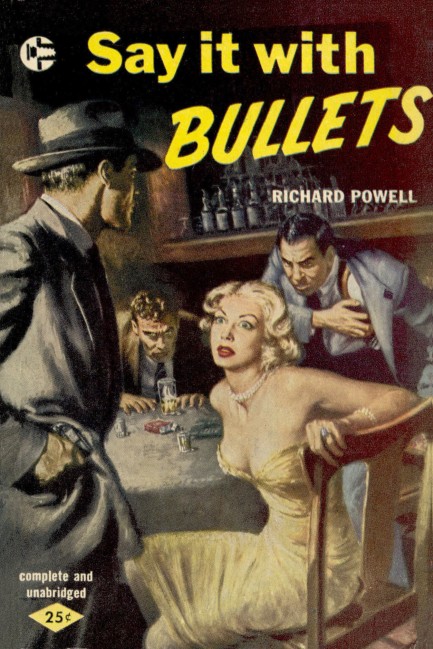
Say It with Bullets was written by Richard Powell and published by Graphic Books in 1954 with great Walter Popp cover art of the instant before all hell breaks loose in a bar. It's the tale of a man named Bill Wayne who, while serving as a pilot in China in World War II, is shot by another pilot, one of five who betray him over half a million dollars in contraband gold. He's left behind but survives, and years later, now in the U.S., has found where each of his almost-killers are residing. He books a spot on a cross-country bus tour called Treasure Trip of the Old West that happens to be passing through those cities, and plans to dispose of his compatriots one by one.
So, obviously, booking a tour that goes through Cheyenne, Salt Lake City, Reno, San Francisco, and Los Angeles, where one's betrayers coincidentally live, is a reach. Actually, let's just call it impossible. But we're believers in accepting the premise of a book, and since Powell explains this set-up in paragraph five we were willing to go with it. Need we say that revenge isn't as clinical as Wayne imagines? It's complicated by a nosy tour director—young and beautiful, of course—an ambitious deputy sheriff, and the growing realization that he's being trailed by a party or parties unknown.
The book is unusual on multiple fronts but the most notable element is that Wayne is one of the biggest wise-asses we've come across in literature. Here's a typical line, delivered after he's taken a beating from the aforementioned sheriff and, dismayingly, run into him the next morning on a street corner: There was Deputy Sheriff Carson Smith, on leave of absence from a dude ranch advertisement. “Hello,” Wayne said. “Did your knuckles recover from that severe bandaging they got here last night?” Wayne is amusing—or tries to be—even in his direst moments. His attitude pushes Say It with Bullets into farce at times, but he also makes an uneven book more interesting than it deserves to be.

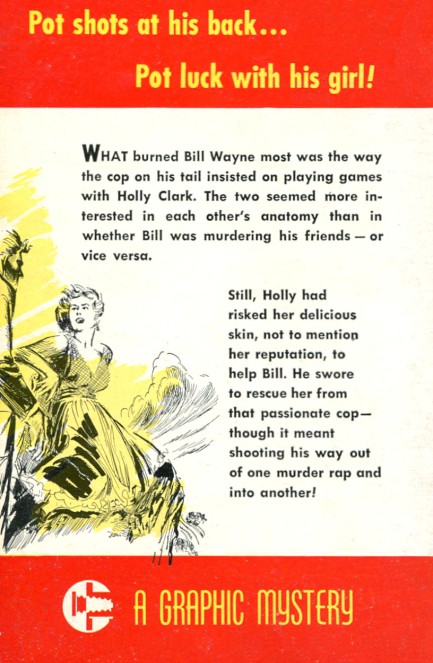


| Vintage Pulp | Oct 11 2023 |

With Bogart and Bacall in the starring roles an unusual fugitive movie takes flight.
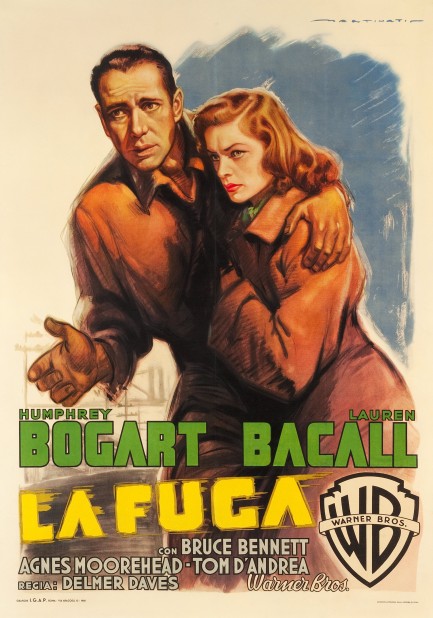
This beautiful poster for La fuga was painted by Italian artist Luigi Martinati, and you doubtless recognize Humphrey Bogart and Lauren Bacall. They starred in four movies together and had a dual cameo in a fifth. This promo was made for their fourth outing Dark Passage, retitled to “the escape” in Italy. And therein lies the plot. Bogart breaks prison and undergoes a backalley cosmetic surgery procedure on his face in order to evade the cops and have a chance to solve the crime for which he was unjustly sent up the river.
The filmmakers decided to use the gimmick of having the first section of the film in Bogart-vision—i.e. first person pov until he gets his new face. It makes sense. Otherwise they'd have needed to have another actor play pre-surgery Bogart, or have resorted to clunky make-up and prosthetics. Bacall co-stars as unlikely shelter and succor, plus the prospect of love—if Bogie can survive. It's a good movie.
But we're going to tack upwind at this point and suggest that Dark Passage, while good, isn't as scintillating as its reputation. Certainly it isn't in the class of To Have and Have Not, Key Largo, or The Big Sleep. But hey—it stars B&B, and that's all audiences of the era really cared about. Three years into her film career Bacall had grown into superstardom—or stardom as it was called back then—and dished out a performance here that did plenty with a thin script and a belief defying scenario.
The other star here is San Francisco, where most of the movie was shot. The city appeared in many period productions, but we can't think of it ever being used to such an extent as in Dark Passage. Since we lived across the Bay in Berkeley for a couple of years, we got to know San Fran well and it's fun to see it as it once was. Dark Passage—slightly overrated and all—is fun too. It premiered in the U.S. in 1947 and reached Italy today in 1948.
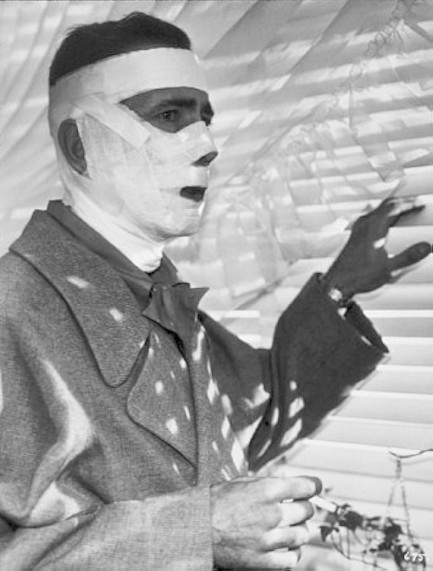
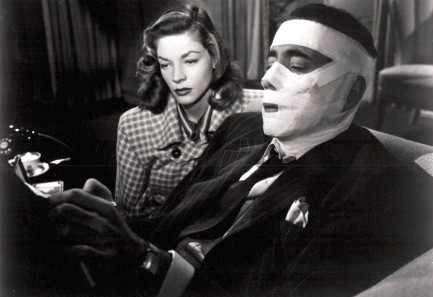
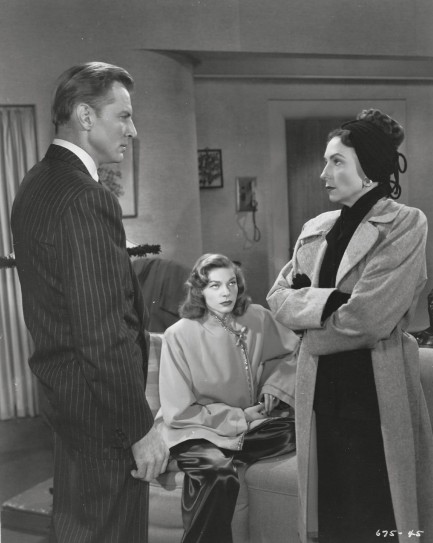
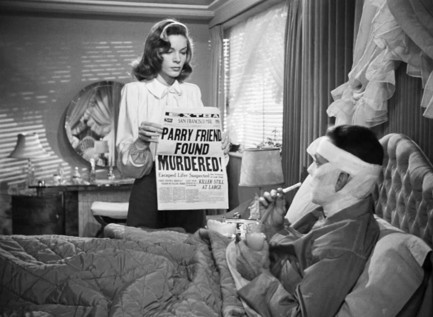

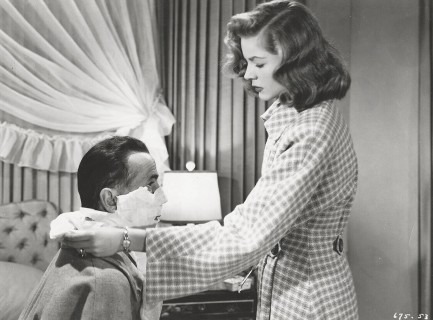
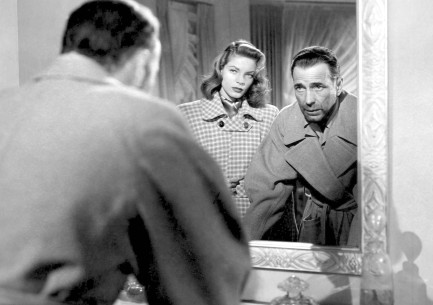


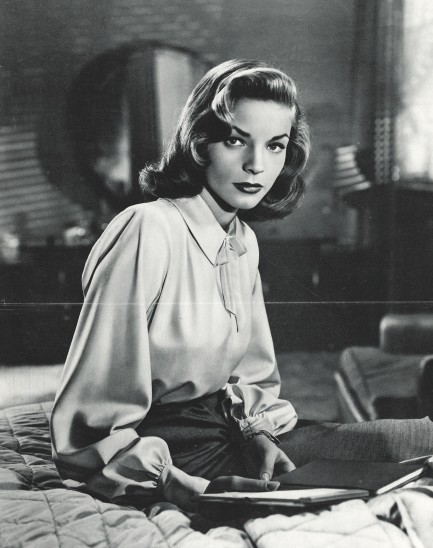
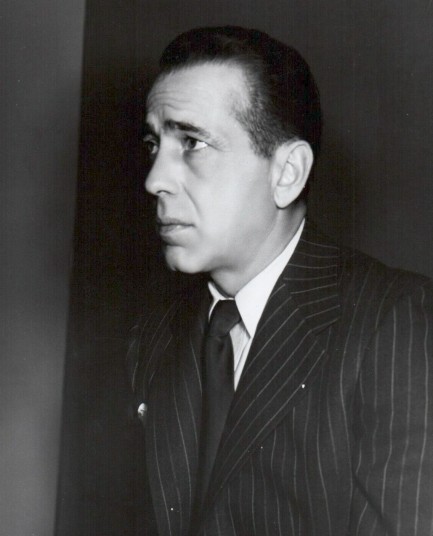
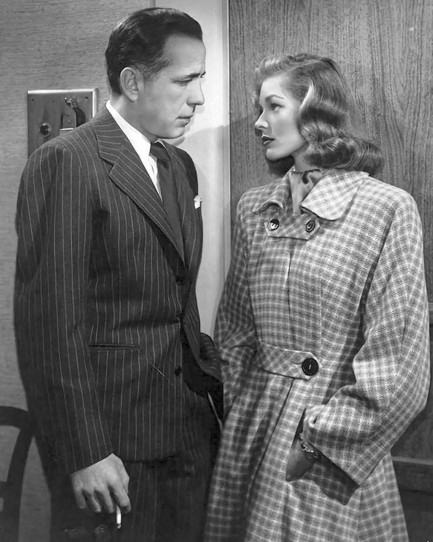
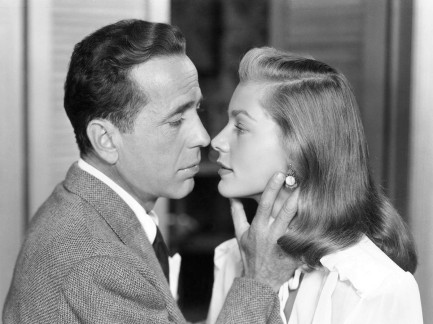













| Vintage Pulp | Sep 16 2023 |

Gemser travels to many distant cities, and meets the worst people in every one of them.
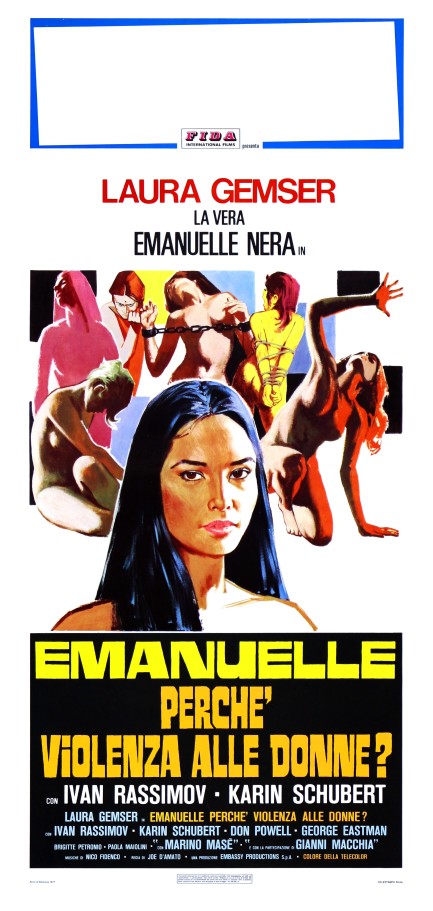
To say that Laura Gemser's Emanuelle films are hit and miss is an understatement of epic proportions. While early entries have the happy softcore feel needed for thought-free diversion and occasional boners, later offerings veer into dark territory. Emanuelle - Perché violenza alle donne? is in the latter category. An Italian production, the title translates as “Emanuelle - Why violence against women?” Erotic cinema and social commentary don't usually mix well—not because they're mutually exclusive, but because the filmmakers never have the skill to pull it off. In the U.S. the movie was retitled Emanuelle Around the World, which sounds fine, but its international English title was changed to The Degradation of Emanuelle. Uh oh.
Gemser's adventures begin in San Francisco when her New York based photo-journalist character enjoys a satisfying boning in the back of a truck. But soon she's off on her next assignment, a titillating expose of a Kama Sutra commune in Asia. Once there she meets creepy guru George Eastman and uses her superior sexual skills to make his holiness transcendentally ejaculate too fast. Up to this point Perché violenza alle donne? is somewhat fun. But next Gemser meets up with pal Karin Schubert in Rome and joins an assignment to expose a sexual slavery ring. Wait—didn't she do that in Emanuelle and the White Slave Trade? Yup, but slavers never quit. This collection of bad men are unusually horrible. One is is a burn victim who rapes his captives. Another has a penchant for bestiality.
Obviously, during the 1970s filmmakers didn't really understand the idea of unintentionally minimizing serious subject matter the same way they do today. It was the “what-the-fuck-let's-give-it-a-try” era, and taking such risks produced some of the greatest cinema ever. But in this case writer/director Joe D'Amato and co-writers Maria Pia Fusco and Gianfranco Clerici failed. Badly. A movie on the subject of slavery and rape would be unpleasant but important if it were a Claire Denis drama or a Laura Poitras documentary. Mixing it into a flyweight sex film doesn't add dramatic weight—it adds discordance, embarrassment, and insult. It was a total miscalculation. You could potentially watch the film until Gemser departs the Kama Sutra commune, then turn it off. If you don't, you have nobody to blame but yourself.
However, we try to see the good in every movie we screen, so we should note that there are some high points. We'll list them. The Emanuelle films were typically shot in exotic locales, and in this case not only does D'Amato set scenes in New York City and San Francisco, but in Kathmandu, Rome, Hong Kong, and—for real—Teheran. Gemser is a limited actress, but one who always does her best with preposterous scripting. Schubert is a stolid co-star. Underutilized Don Powell is always a welcome sight. And lastly, many of the production photos, some of which appear below, are interesting. That's about all the good we can find. We'll just slide Emanuelle - Perché violenza alle donne? into ye olde metaphorical trash bin and forget it ever happened. It premiered in Italy today in 1977.
















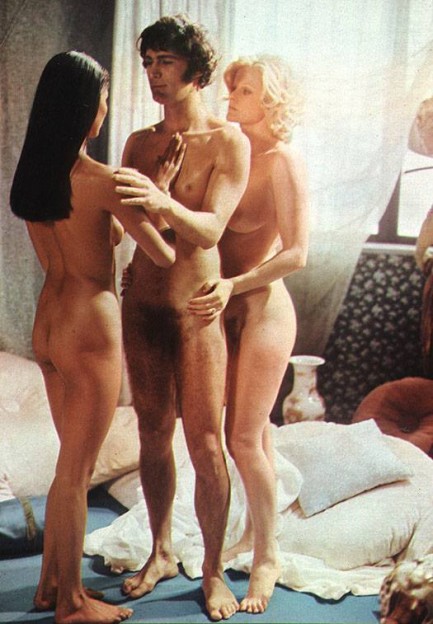
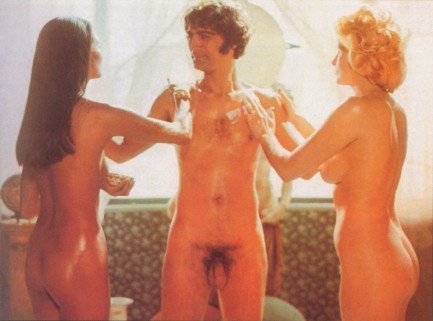
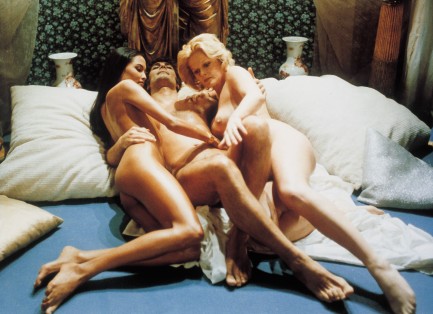
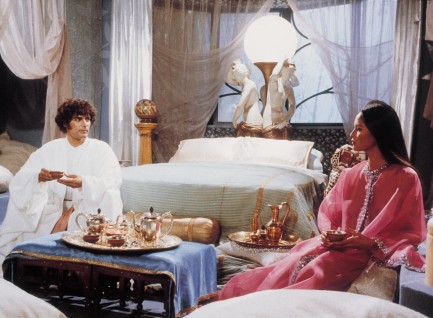

| Vintage Pulp | Sep 4 2023 |

It's not robbery if someone wants you to take it.
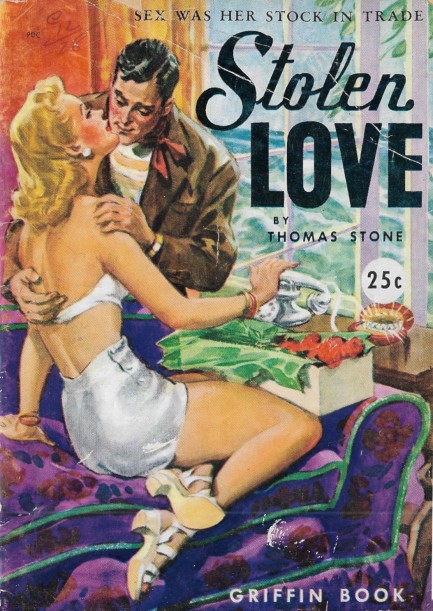
Above is another digest novel from Florence Stonebraker, this time writing as Tom Stone to produce Stolen Love. It was originally published in 1937 as Too Much Love, with this Griffin Books re-issue arriving in 1946 fronted by a cover painted by Glenn Cravath. The book deals with popular New York City radio personality Kay Brinkley—better known as the Voice of Romance—who hosts a lonely hearts call-in show, but is actually cynical about love and thinks her job is a high paying joke.
Her boyfriend asks her to head out to San Francisco to close a business deal for him, and she develops a case of wandering eye before the train even reaches the Rocky Mountains. Once out west she's smitten with the man who's supposed to provide her with important papers, while a couple of other guys, in turn, are seriously smitten by her. Complications arise when her NYC boyfriend unexpectedly flies to San Fran, putting him in direct romantic competition with his business acquaintance.
Kay gets laid with a total of three men as required by most of these digests, and attacked by one, definitely not a requirement, before finally returning to her original boyfriend, a forbearing sort who doesn't begrudge Kay her carnal explorations. The story is a tangled web, written in the usual Stonebraker style, already well in evidence though this was one of her first books. It's no wonder she became such a popular author. She's no Jane Austen, but in the realm of sleazy romance she's about as good as it gets.
| Vintage Pulp | Sep 1 2023 |

Danger there's a Shakedown dead ahead.
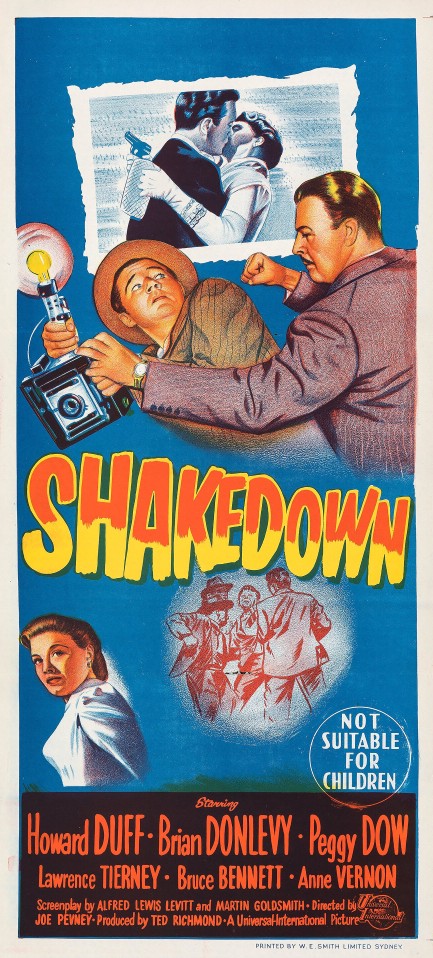
If only real life were bounded by the same rules as mid-century cinema. In real life you can screw someone completely to succeed and in many quarters you're hailed as an amazing talent and can even run for president, but in vintage cinema anyone who succeeds had better do it via fair play or the screenwriters will punish them. In Shakedown, Howard Duff plays an ambitious photographer symbolically named Jack Early, who takes shortcuts to success in San Francisco. He talks his way into a job at a local newspaper, and during his duties quickly reveals himself to be not only ambitious, but amoral. He generates a pile of off-the-books cash with various hustles, and reaches a point where he's full of himself, reckless, and dressing like he runs a stable of hookers on the side.
It's not a surprise when, at this point, in an act of utmost hubris he pits two deadly gangsters against each other by using photos of one engaged in a criminal act. When his blackmail results in one crook blowing the other up with a bomb, Early is right there with his camera and is almost killed too. But he gets the photo. It earns him upper tier status among San Fran lensmen, and the best assignments. But even that isn't enough for him. When one magazine editor offers him top rates for his services, his response is: “The top's too low.”
Clearly someone suffering from this level of egomania is headed for a mugshot session or a mortuary—the mid-century movie censorship regime demanded it. The only question is how exactly does Early go down. We'll only tell you that his journey is entertaining, if unlikely, and the film on the whole is a better than average vintage drama, bolstered by the rock solid Peggy Dow in a supporting role, along with Brian Donlevy and Lawrence Tierney as Gangster A and Gangster B. When it's all over you'll believe the corrupt always lose—on the screen anyway. Shakedown premiered in the U.S. today in 1950.

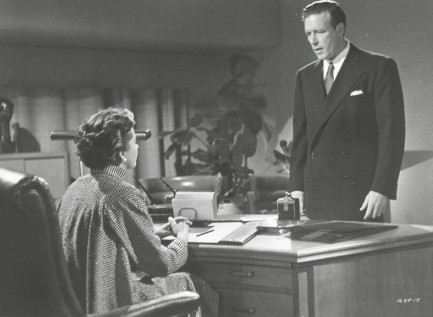
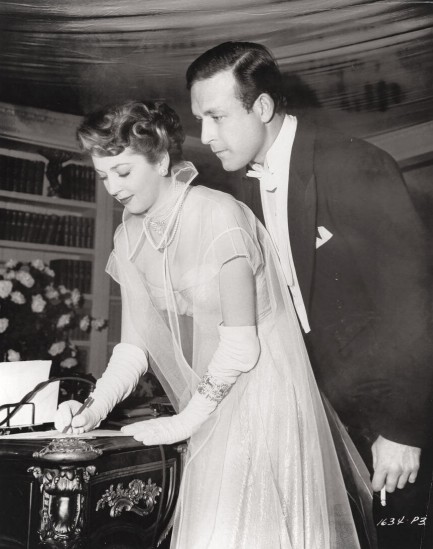
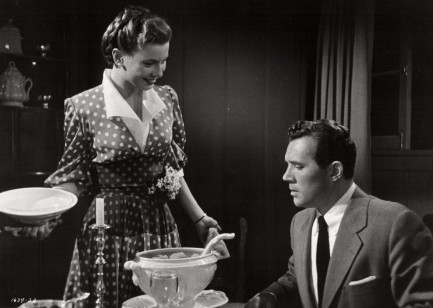
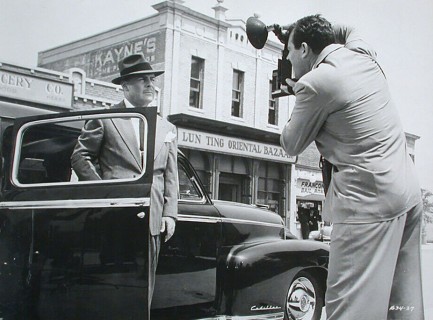
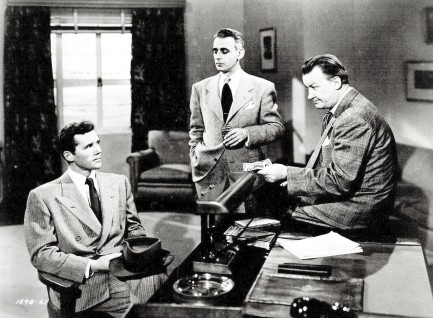
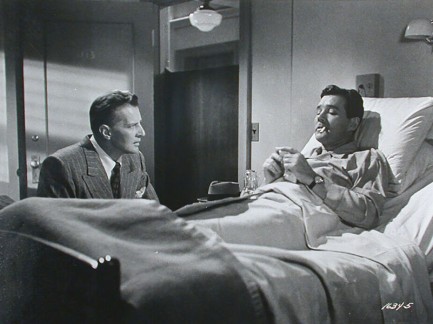
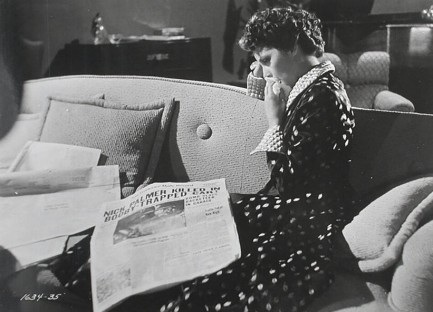
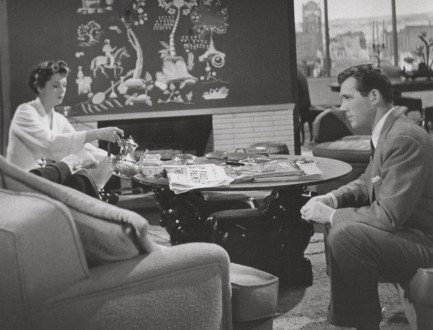
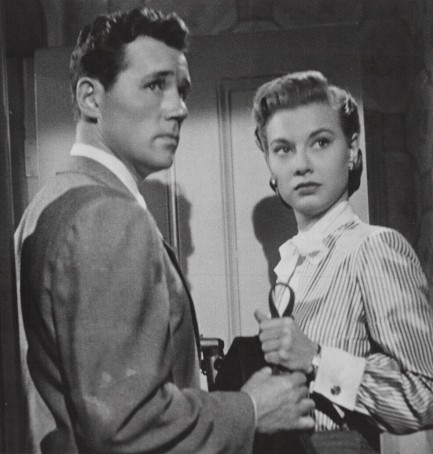
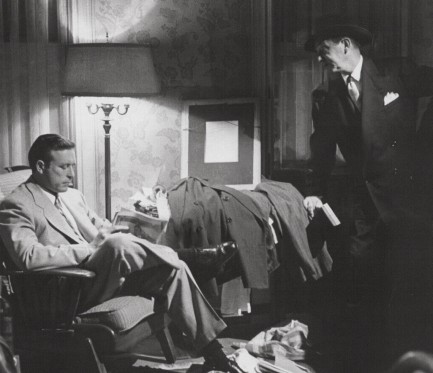
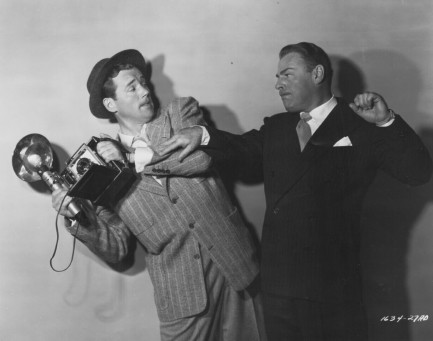
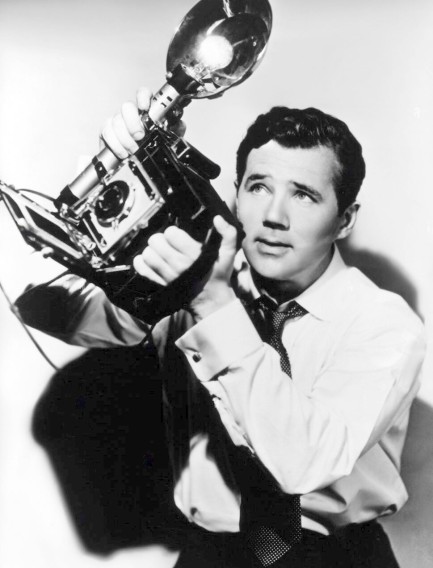
| Vintage Pulp | Aug 31 2023 |

Well, you both meet the basic requirements, but a job like this also hinges on having a big personality.
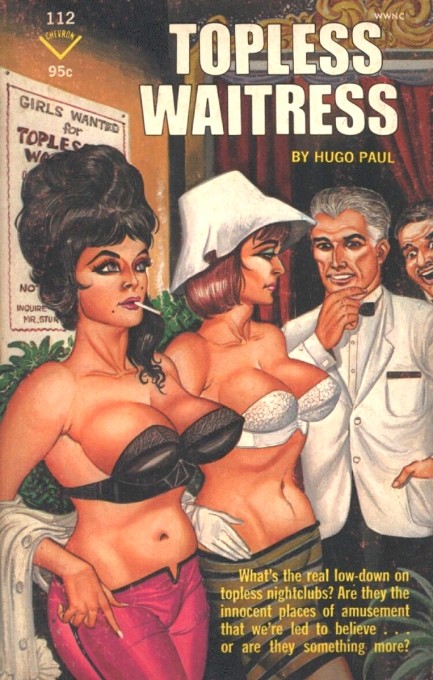
It's been a couple of years since we featured paperback illustrator Gene Bilbrew, so above you see a piece he painted for Hugo Paul's novel Topless Waitress, from Chevron Books in 1967. Paul allegedly wrote as many as 700 sleaze novels under more than forty pseudonyms. That level of output usually makes for rushed and mediocre final results, which was worry enough, along with a thirty dollar price tag, for us to pass on this book. Then we found an electronic copy going for virtually nothing, took the leap, and found ourselves reading the tale of Jody Moran, virginal and headed toward marriage, and her mother Marian, far from virginal and headed toward divorce.
The heart attack death of their father/husband followed by financial need brought on by a business scam sends mother and daughter into the San Francisco nightclub scene, with mom eventually taking a job as the topless waitress of the title, and daughter becoming a topless “a-go-go dancer” in the same club. Along the way they deal with many opportunistic men, including one nightclub owner who manages to bed down both women, pitting them as rivals. Does decadent San Francisco ruin the pair? We won't say. They're sufficiently taken advantage of to satisfy prurient readers. Paul goes lyrical rather than graphic with his sex scenes, which is fine we guess. He's a competent storyteller. In the end, though, we wouldn't say Topless Waitress is anything more than a typical mid-century sleaze novel built on various sexual (and a few sexist) tropes.
The cover art, on the other hand, is far from typical. It features one of Bilbrew's more striking scenes, with his trademark pneumatic women and almost comic book-style execution. He had a singular vision—clearly, considering one woman has a beehive and the other a bucket hat—and was, significantly, one of the only black paperback illustrators during the mid-century period. Since we've seen books with his art go for a hundred dollars, pricewise thirty is actually okay, even enticing, if we were inclined to resell one day. But somehow we never get around to reselling, so we think the cheap e-book route was a good decision. You can see more Bilbrew by clicking here.
| Intl. Notebook | Jul 14 2023 |

I walked home and sat on the stoop and watched the sun sink behind the trees and held the cat. It was a fine cat.

Above is one of the better photos of one of the better writers, Ernest Hemingway, seen here in 1954 at his house Finca de Vigía, which was located in San Francisco de Paula, Cuba. He owned the house and fifteen acre grounds from 1939 to 1960, and it was there that he wrote part of For Whom the Bell Tolls and all of his Pulitzer Prize-winning The Old Man and the Sea. The cat mostly walked across his typewriter keyboard.
| Vintage Pulp | Feb 11 2023 |

A case of the permanent blues.
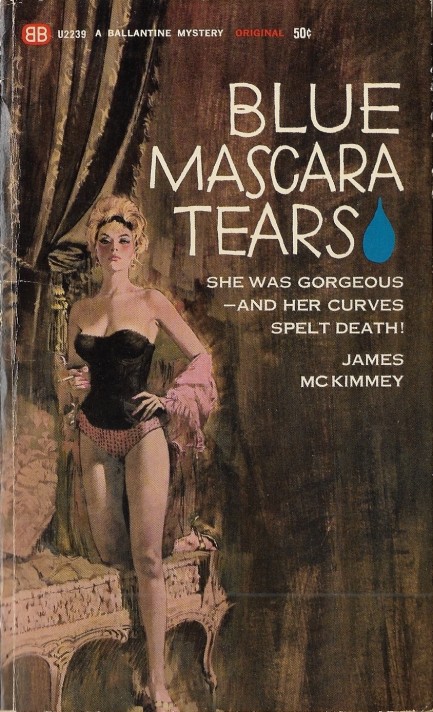
The lyrically titled Blue Mascara Tears is a dark one from James McKimmey, author of able efforts such as The Long Ride and Cornered. In the tale a San Francisco cop named Jack Cummings can't nail crime kingpin Knocko Cutter because the fix is in at the police department. Cutter also employs two vicious and efficient torturer-killers to silence witnesses, which works for a while, but as Cummings notes, “The collapse was coming from the fault in the structure itself.” In other words, the kingpin's sociopathic nature compels him to mistreat his most trusted henchmen, and even henchmen have a breaking point.
Two events are threaded through the plot: the robbery and murder of a man who had $65,000 in his possession; and the rape of a fourteen-year-old girl. The crimes quickly tie together, reveal twists and lies, and the kingpin's search for the missing cash presents the most meager of openings for Cummings to possibly nail him. But that's easier said than done when the police department is corrupt from top the bottom. Realizing the odds are long, Cummings grows more determined—and more willing to cross the line. It all leads to a climax that's expertly dragged out to the final paragraph.
And speaking of experts, the front on this 1965 Ballantine paperback was painted by Ron Lesser, one of the more accomplished illustrators of the mid-century period. Occasionally everything dovetails perfectly with cover design. Here you have excellent art from Lesser, a unique choice for a font, and a perfect blue teardrop, which we assume was an inspiration from Ballantine's art director. Add them together with McKimmey's story and Blue Mascara Tears is a through-and-through success.
| Vintage Pulp | Dec 4 2022 |

A long day's journey into sleaze.

After reading Stan Shafer's Heat, which we tried only because it had Kitty Swan on the front, and Rand McTiernan's Doctor's Dirty Tricks, which we tried only because it had Christina Lindberg on the front, we had one of our recurring cycles of interest in ’60s and ’70s sleaze novels and decided to download a few. First up is 1971's Hard Rider by Conrad Grimes, which we chose because it was published by top sleaze imprint Midwood. The book is about pals Annie and Claudia, who buy a van, paint it psychedelically, and set out from Kentucky to see the world. Or at least the United States. Or at least the groovy parts. They head east to New York City, then west to San Francisco, and manage to have all the expected cultural-sexual adventures of the era. They unknowingly star in clandestinely filmed pornography, sojourn in an all women's commune called the Sisterhood that's devoted to eradicating men, and enjoy sweet lesbian love with each other. Annie eventually finds her place as a West Coast political radical, and Claudia finds home and hearth in the heartland. The book is nothing special, on any level, even though it's incredibly raunchy. But even raunch demands skill. Grimes could use more.
| Vintage Pulp | Sep 24 2022 |

I know—a magenta coat and white beret are bold choices for a clandestine meeting. But just look at the results.
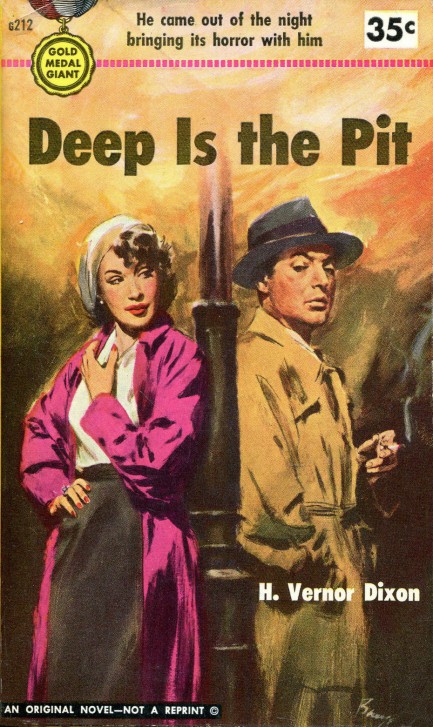
Deep Is the Pit, for which you see Barye Phillips cover art above, is the story of a thief and killer named Marty Lee, who, like Stringer Bell of The Wire, tries to plow his ill-gotten gains into legitimate business. In this case, he swings a deal to buy the decaying old Stannard Hotel in San Francisco, which he turns into one of the hot spots of the West Coast by installing several themed bars and nightclubs. Since all his crimes were committed under a well established false identity and in disguise, he feels pretty safe, even when hostelry success makes him part of Frisco's highly scrutinized glitterati. There's only one snag—his former girlfriend from his criminal days is still around. But because she wants to make it big as a singer and actress, she has no reason to cross a guy who now owns some of the best clubs in California. Her knowledge of his past is neutralized by her ambition, and that's the only reason he hasn't killed her. Well, not the only reason. She's also great in bed.
He eventually jilts her for the rich daughter of the Stannard clan, Karen, and it's here that we see Marty's true colors. His bride is a virgin, and he pretty much ruins sex for her from the word go by ravaging her like an animal, which is the way he's always done it. Her pain and humiliation don't matter to him. He thinks her growing reluctance and eventual refusal to have sex with him is her fault. Even though he understands on some level that she needs gentleness and affection, he can only take what he wants, at whatever time and as violently as his mood dictates. He inevitably turns back to his old girlfriend, carrying on an affair while his upper crust marriage appears on the surface to be a happy one. Yet at the same time, he's very attached to his wife. It isn't love. It's something more akin to bedazzlement.
H. Vernor Dixon is one of those writers who lacks a strong or notable style, yet still puts a story across entertainingly. We were never tempted to skip even a paragraph. It's at about the two-thirds point that Marty's problems arrive in a bunch. His hotel is robbed by some of the subordinates he trained in the art of theft, an underworld figure with whom he's had dealings starts hanging around the property, and his old girlfriend suddenly wants more than just a singing career—or else. He can't do much about the robbers or the mobster, but he can handle his old flame. If he gets rid of her, his other problems will likely sort themselves out. But in these books supposedly disposable women can have tricks of their own up their sleeves. Deep Is the Pit ultimately hinges on Marty's desperate attempt to murder his mistress, which Dixon manages to describe tautly and with good twists. The pit is deep indeed, but for readers falling in is a good time.
H. Vernor Dixon is one of those writers who lacks a strong or notable style, yet still puts a story across entertainingly. We were never tempted to skip even a paragraph. It's at about the two-thirds point that Marty's problems arrive in a bunch. His hotel is robbed by some of the subordinates he trained in the art of theft, an underworld figure with whom he's had dealings starts hanging around the property, and his old girlfriend suddenly wants more than just a singing career—or else. He can't do much about the robbers or the mobster, but he can handle his old flame. If he gets rid of her, his other problems will likely sort themselves out. But in these books supposedly disposable women can have tricks of their own up their sleeves. Deep Is the Pit ultimately hinges on Marty's desperate attempt to murder his mistress, which Dixon manages to describe tautly and with good twists. The pit is deep indeed, but for readers falling in is a good time.





































































